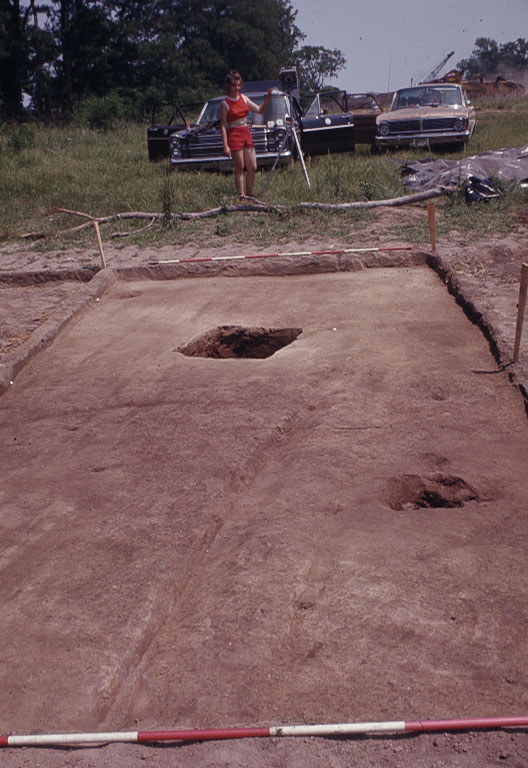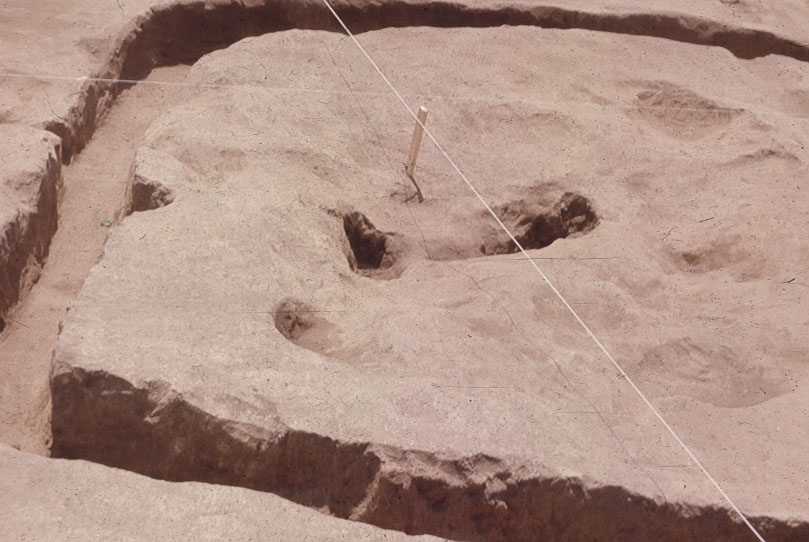The Hallowes Site (44WM6)
Introduction
The John Hallowes site (44WM6), well-known among archaeologists as one of two documented 17th-century fortified
domestic compounds on Virginia's Northern Neck, is located on Currioman Bay at the juncture of Nomini Bay
and the Potomac River in Westmoreland County. The site is important for its connection to John Hallowes,
who emigrated from England to Maryland in 1634 as an indentured servant to Thomas Cornwallis and died in
Virginia in 1657 as one of the wealthiest and most influential citizens on the Northern Neck.
While in Maryland, Hallowes had joined the rebels in Ingle's Rebellion (1645-1646), an unsuccessful
attempt to overthrow the proprietary government in that colony. After Baltimore quelled the uprising,
Hallowes and the other rebels were forced to take an oath of fealty in 1647. Instead, Hallowes relocated
across the river to Virginia. His service as a county commissioner from 1653 to 1657 and sheriff of
Westmoreland County in 1657 as well as his extensive land holdings placed him among the county elite.
Following his death, his widow, daughter, and granddaughter owned the property, but it was likely occupied
by tenants from 1666 until its abandonment in 1681.
The 20-by-50 foot dwelling is an important early example of an earthfast hall/chamber house with an
off-center chimney and is particularly significant for the bastions built into opposing gable
end corners of the building. Excavated in the late 1960s, the fortified house has been widely
interpreted as a defensive response by Hallowes' descendants to Susquehannock raids preceding
Bacon's Rebellion in 1676. Reanalysis of the artifacts and additional archival research undertaken
by Brad Hatch, Lauren McMillan, and Barbara Heath at the University of Tennessee, Knoxville, has
refined the site's chronology, supporting an earlier date for the structure, placing its construction
in the late 1640s.
Archaeological Investigations
 Excavation shot, Hallowes site, 1969 (Virginia Department of Historic Resources)
Excavation shot, Hallowes site, 1969 (Virginia Department of Historic Resources)
William T. Buchanan Jr. directed excavations at the site from July 1968 until August 1969 with
the assistance of a volunteer crew. Edward Heite and Virginia Sherman were also involved in
research relating to the project. The site was gridded into 50-foot-square lots which were subdivided
into 10-foot units. Plow zone was removed from each unit mechanically or by shovel without screening.
Based on field photographs, it appears that the features were excavated by hand with the use of trowels.
Feature fill was not screened.
All features and units were given unique identification numbers, with the plow zone numbered by lot,
the features given sequential numeric designations, and layers within features recorded with the use
of feature numbers and letters. Most of the artifacts recovered from the site have been designated as
"surface collected" and, because these materials are relatively large in size, appear to either have
been collected from the piles of stripped plow zone or were discovered on the stripped surface when
the group of volunteers returned on the weekend. Some of the larger features were recorded in some
detail, including two large pits located northeast and southwest of the structure. In many cases,
post holes and their molds associated with the structure and fences were excavated as a single deposit.
Reanalysis of the archaeological assemblage yielded a terminus post quem of 1675, an adjusted
Mean Ceramic Date of 1667, and a Binford pipe stem date of 1660. None of the artifacts, with
the exception of two clearly intrusive fragments of ironstone that were surface collected,
appear to date after 1681, and all fall comfortably within the proposed 1647-1681 occupation
range suggested by the historical evidence.
 Corner bastion, excavated, Hallowes site (Virginia Department of Historic Resources)
Corner bastion, excavated, Hallowes site (Virginia Department of Historic Resources)
Two phases of occupation have been identified for the site. The first phase dates from 1647
until 1666 and included the occupation of John Hallowes, his first wife, Restitute Tew, his
second wife, Elizabeth Sturman, and Elizabeth's second husband, David Anderson. It was during
the initial phase that the main house was built and fortified with bastions. From 1666 until
the abandonment of the property in 1681, the house was occupied by tenants. During this time,
the bastions were removed and the ditch-set fences were built. A 20-foot-square addition may
also have been added to the east façade.
Artifacts
The Hallowes site produced an assemblage of 4,581 artifacts and 3,675 faunal remains,
excluding nine artifacts on loan to the Westmoreland County Museum that were unavailable
for study (these artifacts are discussed in more detail, below). Eight boxes of brick were
also excluded from the reanalysis although these items remain with the collection.
Ceramics produced in Europe (or by an English colonist) comprise the majority of the artifact
assemblage at 34 percent (n=1,599), representing a minimum of 199 vessels. Coarse earthenwares
form 91percent of the ceramic assemblage. Morgan Jones ware, produced by the colonist Morgan
Jones, constitutes the greatest number of ceramics found on the site (n=923). Other major
earthenware types include Mérida Micaceous, North Devon gravel-tempered ware, and tin-glazed
earthenware. Stoneware, primarily Rhenish blue and gray, comprised 9 percent of the assemblage.
Rarer ceramic ware types include Martincamp (earthenware), North Italian slipware, Metropolitan
slipware, Raeren brown stoneware, Saintonge, and Spanish star costrel.
Clay tobacco pipes make up 22 percent (n=1,021) of the assemblage. Twenty-one of these pipes
are marked imported pipes and 13 are locally-made decorated pipes. Most of the local pipes are
handmade, but mold-made pipes include a type known as "Bookbinder," and pipes with rouletting
at the stem-bowl juncture. The Bookbinder pipe has also been found across the Potomac River in St. Mary's City and at
the Old Chapel Field site on St. Inigoes Manor. Only seven pipes (four imported and three local)
were recovered from features.
Vessel glass consists of 279 fragments representing three case bottles, a globe-and-shaft
shaped wine bottle, and a phial, and a minimum of two stemware vessels. Horse furniture
includes a stirrup, a spur, a fragmentary bit, three buckles, a leather ornament, and three
boss fragments. Pieces of five knives and an intact Puritan-style spoon bowl are present
as well as a small number of adornment items, straight pins, two pair of scissors, and a
bale seal. Gunflints and lead shot were also recovered.
Architectural artifacts in the catalog include a small quantity of brick and mortar and over
800 nails, as well as a few fragments of window lead and a single piece of window glass.
The faunal remains include a wide variety of species of which cow and pig predominate, making up
39 percent and 33 percent of the identified taxa, respectively. Small numbers of chicken bones
were also found. Wild animals were represented by deer (almost 20 percent of the identified
faunal assemblage), goose, duck, mole, muskrat, rabbit, raccoon, squirrel, and turkey.
Turtle, shark, gar, clams and black drum, along with oyster shell, completed the assemblage.
Hatch has argued that the presence of quarters and axial portions of older, larger deer, and
the absence of head portions, suggests that Hallowes was involved in the deerskin trade.
Nine diagnostic artifacts were previously reported by Buchanan and Heite but were unavailable
for reexamination. These nine artifacts were placed on loan with the Westmoreland County Museum
in July 1976 and have since been lost. These artifacts included two mended Rhenish blue and
gray stoneware medallion fragments bearing a date of 1632. This medallion is one of the
earliest dated pieces of ceramic in the Chesapeake. A locally-made pipe stem and a bowl
fragment from context 29A are also included in this group. These two fragments mended to
form a nearly complete pipe with a running deer motif on the bowl. At least two marked
English pipe fragments, a stem and bowl, are also lost. A Morgan Jones-type pan base
fragment and a rim fragment and a pot fragment also appear to be missing. Finally, a
large reconstructed colonoware collared bowl from context 105A is no longer in the
collection. Tobacco pipes illustrated in Buchanan and Heite's 1971 article are also no
longer in the collection. It is unknown whether these objects were also loaned to the
Westmoreland County Museum since no record of them exists.
References
Buchanan, William T. and Edward F. Heite. 1971. The Hallowes Site: A
Seventeenth-Century Yeoman's Cottage in Virginia. Historical Archaeology 5:38-48.
Hatch, D. Brad. 2012. Venison Trade and Interaction between English
Colonists and Native Americans in Virginia's Potomac River Valley. Northeast Historical Archaeology 41:18-49.
Hatch, D. Brad. 2015. An Historical Archaeology of
Early Modern Manhood in the Potomac River Valley of Virginia, 1645-1730. Doctoral dissertation, Department of
Anthropology, University of Tennessee, Knoxville.
Hatch, D. Brad, Barbara J. Heath, and Lauren K. McMillan. 2014. Reassessing the
Hallowes Site: Conflict and Settlement in the 17th-century Potomac Valley. Historical Archaeology 48(4):46-75.
Hatch, D. Brad, Lauren K. McMillan, and Barbara J. Heath. 2013.
Archaeological Reassessment of
the Hallowes Site (44WM6). Report to the Virginia Department of Historic Resources, Richmond, VA.
Hodges, Charles T. 1993. Private Fortifications in 17th-Century Virginia:
A Study of Six Representative Works. In The Archaeology of 17th-Century Virginia, edited by
Theodore R. Reinhart and Dennis J. Pogue, pp.183-221. Archeological Society of Virginia, Richmond, VA.
Hodges, Charles T. 2003. Forts
of the Chieftains: A Study of Vernacular,
Classical and Renaissance Influence on Defensible Town and Villa Plans in 17th-Century Virginia.
Master's Thesis, Department of Anthropology, The College of William and Mary, Williamsburg, VA.
Accessed 12 April 2013.
McMillan, Lauren. 2015. Politics, Conflict, and
Exchange in the Chesapeake: An Archaeological and Historical Study of the Tobacco Pipe Trade in the Potomac Valley,
ca. 1630-1730. Doctoral dissertation, Department of Anthropology, University of Tennessee, Knoxville.
McMillan, Lauren. 2016. The Multiple Interaction Spheres of Tobacco Pipes
at the John Hallowes Site, Westmoreland County, Virginia. Journal of Middle Atlantic Archaeology.
McMillan, Lauren K., D. Brad Hatch, and Barbara J. Heath. 2014.
Dating Methods and Techniques at the Hallowes Site (44WM6): A 17th-century Example.
Northeast Historical Archaeology 43:18-36.
What You Need To Know To Use This Collection
Some of the most important artifacts from the collection have been lost. Contexts include surface collection, units,
features, and layers (from spoil piles).
Further Information About the Collection
The John Hallowes site collection is owned and curated by the Virginia Department of
Historic Resources. For more information about the collection and collection access,
contact Laura Galke, Chief Curator, at 804-482-6441; email
laura.galke@dhr.virginia.gov.
To Download Data
Data and a variety of other resources from this site are available for download. To download data,
please go to the Downloads page.